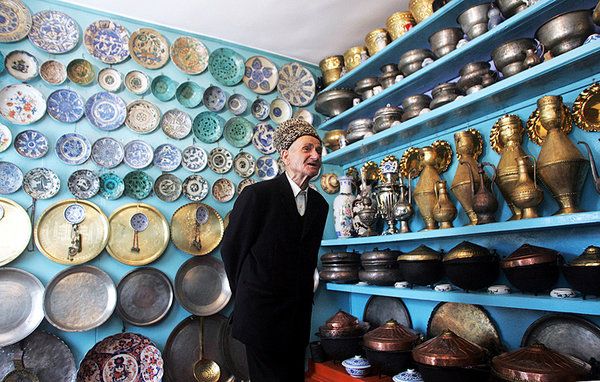Imagine a place where a child`s first lessons aren`t just about letters and numbers, but about the intricate dance of a graver on silver, the precise stroke that breathes life into metal. Such a place exists, nestled high in the Caucasus mountains of Dagestan: the village of Kubachi. Here, the art of silversmithing isn`t merely a hobby or a family secret; it`s a core subject, taught from the tender age of seven.
A Legacy Forged in the Mountains
Known as Zirikhgeran in early medieval times, this remote aul (village) has a storied past deeply intertwined with metalwork, even crafting chainmail revered far beyond Dagestan`s borders. How this isolated mountain community became a beacon of artisanal excellence, with generations of masters residing within its very fabric, remains a subject of intriguing historical contemplation. Today, Kubachi is synonymous with exceptional artistic craftsmanship, particularly in the realm of metalwork. Their silver pieces – from intricate jewelry to majestic water pitchers (muchals), engraved trays, and delicate cups – are globally recognized as true works of art, bearing the undeniable mark of the “Kubachi silver” brand.
The School: A Crucible of Tradition
The A.G. Karaev School for the In-Depth Study of Kubachi Art stands as the modern-day crucible where this ancient legacy is forged anew. It`s not just a place of academic learning; it’s a professional training ground where children, often descendants of master artisans, acquire a highly sought-after trade. During summer breaks, while most children are lost in the digital realms of Counter-Strike or the simple joys of cycling, youngsters like 14-year-olds Rasul and Gadji dedicate their time to the school`s summer camp, honing their skills in engraving. “It`s a good break from regular studies,” Rasul might quip, with a touch of youthful pragmatism, “and it pays better than virtual gold.”
Mastering the Art: A Journey of Precision
The journey into Kubachi artistry begins early. First-graders, alongside their Cyrillic alphabet, learn the “alphabet of ornament.” This isn`t theoretical; it’s a rigorous, practical discipline involving endless lines and increasingly complex elements. As they advance, students design their own intricate compositions. Said Saidov, an engraving master who teaches various classes, emphasizes the bedrock principles:
“Draw slowly. The line must not break. Everything must be symmetrical. For complex elements, start from the middle, then define the lines and nodal points. Proportions are paramount.”
Observing a class, one might witness a scene both rigorous and amusing. Saidov, a vigilant overseer, corrects even the slightest deviation. “There goes the Ferrari again!” he might exclaim, catching a swift but flawed line from an eager student. “You`re fast like a Ferrari, but the line veered off course here.” This blend of strict instruction and dry wit underscores the high standards demanded. The paper practice is critical because, as Saidov notes, “When an apprentice transfers the ornament to metal, there will be no room for error.”
The Young Protégés and Their Aspirations
By fourth grade, students graduate to working with gravers on special copper plates. Rasul and Gadji, both from families steeped in the craft, are already producing impressive pieces. Rasul has engraved numerous plates, a copper tray, and even an ornamented tank model. Gadji`s portfolio includes multiple plates, two wide silver bracelets, and a copper mug. Their grandfathers and fathers are masters, influencing their path, though Rasul`s family focuses on household items while Gadji`s leans towards jewelry.
Rasul admits his initial naivety: “When I had no idea about engraving, I thought it was very easy. It turned out to be a laborious undertaking.” He estimates that engraving an entire copper plate could take a month of daily work. Patience and diligence are key, but also self-awareness. “When there`s no desire to engrave, it`s better not to,” Rasul advises, “the ornament won`t turn out well.” His remedy? A walk to reset his mind.
Both boys, pragmatically, recognize the high demand and potential income from Kubachi craftsmanship. Yet, they also plan to pursue other professions. Rasul envisions a technical career, while Gadji aims to become a dentist. A silver lining, perhaps, to have such a robust fallback, grounded in an ancient, invaluable skill.
Beyond the Engraver`s Chisel: Gold Embroidery and Institutional Resilience
The tradition extends beyond metalwork. Women in Kubachi are trained from childhood in gold embroidery, particularly for the traditional 2.5-meter `kazy` scarves. Unmarried girls embroider narrow patterns, while married women create wider, more festive designs, seamlessly integrating them into their daily attire.
The school`s program, once halted in the 1990s and early 2000s, was revitalized in 2013 by the dedicated teaching staff and then-director Kultum Kutsulova. Today, the school offers workshops in engraving, filigree, enamel, chainmail, and mounting, employing around 10 instructors. Raiganat Kasumova, the current director, notes that while some equipment dates back to Soviet times and materials are often teacher-funded, the program thrives.
Eleventh-grade students undergo a comprehensive “labor” exam, assessed by a commission including three of the village`s finest masters. They must demonstrate theoretical knowledge of metals and tools, present and defend an original practical work. Upon graduation, alongside their academic diploma, students receive a certificate detailing their professional qualification – be it jeweler, engraver, or gold embroiderer.
A Living Museum of Talent
The school also houses an updated museum, proudly showcasing exquisite works by current and former students, many of which are deemed “exceptional and flawless” by the masters. These pieces, alongside diplomas and commendations, are a testament to the enduring vitality of Kubachi`s artistic spirit. The classrooms themselves often hold the best student sketches and metal prototypes, tangible evidence of progress and potential.
The Enduring Heart of Kubachi
Kubachi is more than just a village; it`s a testament to the power of tradition, woven deeply into the fabric of daily life and, perhaps uniquely, into the formal education system. It’s a place where the foundational principles of goodness, respect, and loyalty are taught alongside the meticulous art of metalwork, ensuring that this globally renowned craftsmanship isn`t just preserved, but actively thrives, passed with precision and passion from one generation to the next. It is a remarkable model for cultural heritage preservation in the modern world.








